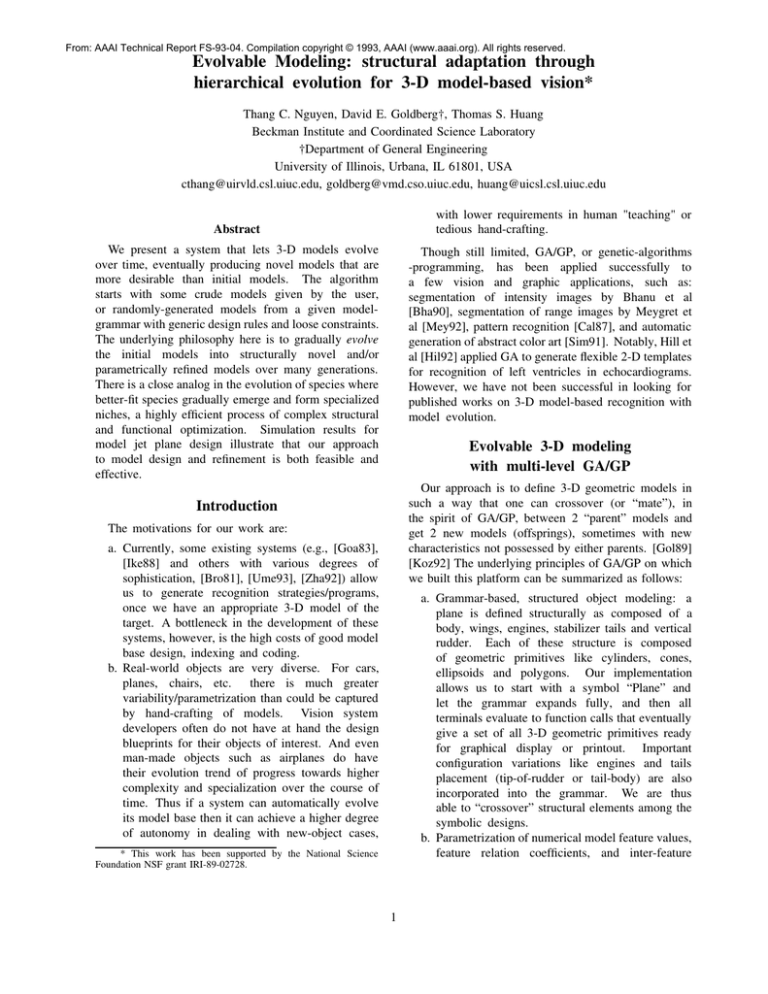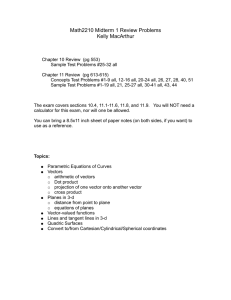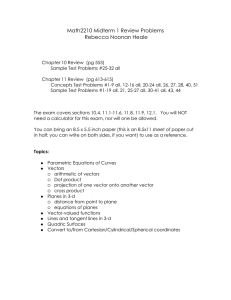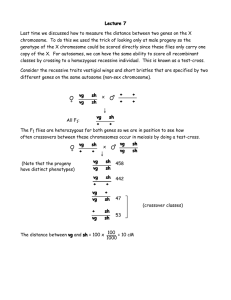
From: AAAI Technical Report FS-93-04. Compilation copyright © 1993, AAAI (www.aaai.org). All rights reserved.
Evolvable Modeling: structural adaptation through
hierarchical evolution for 3-D model-based vision*
Thang C. Nguyen, David E. Goldberg†, Thomas S. Huang
Beckman Institute and Coordinated Science Laboratory
†Department of General Engineering
University of Illinois, Urbana, IL 61801, USA
cthang@uirvld.csl.uiuc.edu, goldberg@vmd.cso.uiuc.edu, huang@uicsl.csl.uiuc.edu
with lower requirements in human "teaching" or
tedious hand-crafting.
Abstract
We present a system that lets 3-D models evolve
over time, eventually producing novel models that are
more desirable than initial models. The algorithm
starts with some crude models given by the user,
or randomly-generated models from a given modelgrammar with generic design rules and loose constraints.
The underlying philosophy here is to gradually evolve
the initial models into structurally novel and/or
parametrically refined models over many generations.
There is a close analog in the evolution of species where
better-fit species gradually emerge and form specialized
niches, a highly efficient process of complex structural
and functional optimization. Simulation results for
model jet plane design illustrate that our approach
to model design and refinement is both feasible and
effective.
Though still limited, GA/GP, or genetic-algorithms
-programming, has been applied successfully to
a few vision and graphic applications, such as:
segmentation of intensity images by Bhanu et al
[Bha90], segmentation of range images by Meygret et
al [Mey92], pattern recognition [Cal87], and automatic
generation of abstract color art [Sim91]. Notably, Hill et
al [Hil92] applied GA to generate flexible 2-D templates
for recognition of left ventricles in echocardiograms.
However, we have not been successful in looking for
published works on 3-D model-based recognition with
model evolution.
Evolvable 3-D modeling
with multi-level GA/GP
Our approach is to define 3-D geometric models in
such a way that one can crossover (or “mate”), in
the spirit of GA/GP, between 2 “parent” models and
get 2 new models (offsprings), sometimes with new
characteristics not possessed by either parents. [Gol89]
[Koz92] The underlying principles of GA/GP on which
we built this platform can be summarized as follows:
Introduction
The motivations for our work are:
a. Currently, some existing systems (e.g., [Goa83],
[Ike88] and others with various degrees of
sophistication, [Bro81], [Ume93], [Zha92]) allow
us to generate recognition strategies/programs,
once we have an appropriate 3-D model of the
target. A bottleneck in the development of these
systems, however, is the high costs of good model
base design, indexing and coding.
b. Real-world objects are very diverse. For cars,
planes, chairs, etc. there is much greater
variability/parametrization than could be captured
by hand-crafting of models. Vision system
developers often do not have at hand the design
blueprints for their objects of interest. And even
man-made objects such as airplanes do have
their evolution trend of progress towards higher
complexity and specialization over the course of
time. Thus if a system can automatically evolve
its model base then it can achieve a higher degree
of autonomy in dealing with new-object cases,
a. Grammar-based, structured object modeling: a
plane is defined structurally as composed of a
body, wings, engines, stabilizer tails and vertical
rudder. Each of these structure is composed
of geometric primitives like cylinders, cones,
ellipsoids and polygons. Our implementation
allows us to start with a symbol “Plane” and
let the grammar expands fully, and then all
terminals evaluate to function calls that eventually
give a set of all 3-D geometric primitives ready
for graphical display or printout. Important
configuration variations like engines and tails
placement (tip-of-rudder or tail-body) are also
incorporated into the grammar. We are thus
able to “crossover” structural elements among the
symbolic designs.
b. Parametrization of numerical model feature values,
feature relation coefficients, and inter-feature
* This work has been supported by the National Science
Foundation NSF grant IRI-89-02728.
1
Experiments on modeling of
jetliners through simulated evolution
constraints. For example, we define many
numerical parameters in terms of other parameters.
The numerical parameters are coded into binary
strings that can be crossed and give children binary
strings.
c. Performance feedback, either from human user
or automatic recognition process, contributes to
shape the path of model evolution: current models
that are more similiar to desirable models have
more chance of surviving and evolving further.
Evolution processes have been shown to be much
more efficient than random search, and also a
robust approach to optimization [Goldberg89].
We present results of a typical run of interactive
design of jetliners.
However, with appropriate
augmentation, the same system here can be embedded
as a hypothesis generator and model acquisition module
within a fully automatic object recognition system.
The planeStructure, such as those in figure 1(a),
is constructed according to a planeGrammar, whose
rewriting rules are as follows:
Plane—>DesignPlane[ Body, AllEngines, Wings,
Tails, Rudder ]
Body—>SketchBody[ midbodyLength,
tailLength, bodyDiameter ]
AllEngines—>EnginesPick[ NumOfEngines[ Random[ ] ]
WEngines—>WEnginesAt[ WEngineFromBase ]
BEngines—>BEnginesAt[ BEnginesFromEnd ]
Wings—>SketchWings [ wingHSpan, wingbaseWidth, wingXbaseWidth, wingbaseleadPointX, wingElbowK, wingSweep, wingtipWidth
]
Tails—>SketchTails[ tailHSpan, tailbaseWidth,
tailtipWidth, tailSweep, tailsMount ]
Rudder—>SketchRudder[ rudderbaseWidth, ruddertipWidth, ruddertipHeight, rudderSweep ]
With respect to genetic operations (crossover and
mutation), each of our models has 2 levels:
Structural level: with a production grammar and
symbolic parameters. A model design expressed
at this level has the form of a tree with symbolic
parameters. A crossover at this level is performed
by exchanging 2 subtrees of the same functionality:
e.g., 2 Wings subtrees.
binary string level: for the coding of numerical
parameter values. At this level, a crossover
between 2 models can be performed by crossing
2 binary strings, both of which refer to some
common parameter, e.g. WingHalfSpan.
Plane A
Engines
Body
Wings
Tails
Plane B
Rudder
Body
Engines
Wings
Tails
We allow each of our numerical parameters to take
on its value within some constraint interval, into which
its binary string will be mapped and interpreted. There
are 19 parameters which participate in GA-style genetic
operations. Most of these parameters are not dependent
on some other parameters, except wingbaseleadPointX,
wingElbowK, wingEngineFromBase, and bodyEngineFromTailEnd. Following is a partial list of the parameter
constraints:
Rudder
TailEngine
WingEngines
BodyEngines
CrossOver
(a) Structural crossover (Engines)
{0, 1, 1, 0}
{1, 0, 1, 0}
Value = 5.8
{1, 0, 0, 1}
{0, 1, 0, 1}
Value = 4.1
• {midbodyLength, IsWithin, {6.0, 9.0}}
• {bodyDiameter, IsWithin, {0.8, 1.2}}
• {wingHSpan, IsWithin, {4.5, 6.8}}
• {wingbaseWidth, IsWithin, {1.8, 3}}
• {wingbaseleadPointX, IsWithin, {0.52, 0.65}, midbodyLength}
• {wingElbowK, IsWithin, {0.15, 0.35}, wingHSpan}
• {wingEngineFromBase, IsWithin, {0.25, 0.5},
wingHSpan}
• {bodyEngineFromTailEnd, IsWithin, {-0.15, 0.05},
midbodyLength}
(b) Binary strings crossover.
Figure 1. Crossover between 2 planes at
the structural level (Engines), and binary
string level for numerical parameter values.
In practice, some substructure is picked randomly,
from among all substructures of a symbolic design, for
crossover or mutation. This has the same effect of
hierarchical sampling of both structures, like GP, and
parameters (with GA string operations).
A constraint interval by itself does not give a
parameter value directly, but given a N-bit binary string
S for any independent parameter and its corresponding
parameter constraint interval {lowerpoint, upperpoint},
2
the parameter value is determined as follows:
c. The two models with highest scores are then
selected for crossover, or “mating”. One randomly
selected model (among the current 4) is then
“mutated”. And one new model will be randomly
generated (in the manner of the first-generation
models.) This process creates the new generation
of 4 models.
d. The above loop in (b) and (c) is continued until
at least one model is given a score higher than
a threshold of acceptability (say, any model to
be accepted has score > 100.) Alternatively,
a maximum number of generations can be set
beforehand, and many runs can be tried.
where Sk is the kth bit’s value (0 or 1). This is just
a simple linear mapping of the binary string S into the
interval, including the lower end point.
In the case of a parameter that depends on some
other parameter(s), the parameter’s value is generally
computed as an expression. For example, suppose
we have a string 0110 for wingEngineFromBase, and
suppose the value of wingHSpan is 4.96, one first
computes the string’s value to be 0.35, and then one
uses that 0.35 as a coefficient to compute the value for
wingEngineFromBase to be 0.35 * 4.96, which is 1.736.
The same is true of the other dependent parameters.
There are also parameters whose values are kept
constant, and those relations between parameters, which
are actually equations with evolvable variables (those
parameters coded into GA binary strings). We called
these parameters, in rule form, HiddenParameters
(two of them, BodyTailsMount and RudderTailsMount,
are 3-D vector-valued functions).
Even though
HiddenParameters do not directly participate in
any genetic operations, those that depend on the
"evolvable" 19 parameters do have their values
indirectly "evolvable". Here are some of them:
We keep a simple format for quick comprehension
of the process. See figure 2: there are 4 populations,
from the 0th generation to the 3rd generation of the
evolution process. In each population (except the 0th
generation), models at positions 1 and 2 are children of
a crossover operation (sexual production) from the last
generation; model at position 3 is a mutated offspring;
and model at position 4 is a new randomly generated
model. Incidentallly, we view a mutation as a crossover
with some random unknown model, which is appropriate
in our framework. Figure 3 shows 4 views of the best
model found.
Comments and Conclusions
rudderbaseHeight—> tailLength * sin[ 0.1 ] + 0.02
rudderleadPointX—> rudderbaseWidth – tailLength
+ 0.05
BodyTailsMount—> { tailbaseWidth – tailLength +
0.05, 0, rudderbaseHeight }
RudderTailsMount—> { rudderleadPointX – rudderSweep + 0.05, 0, ruddertipHeight – 0.1 }
We have demonstrated that it is feasible to evolve 3D jet models to search for better models, starting from
random models. There are many ways to apply our
evolvable modeling system. This is one method to let
a system learns to acquire new 3-D models with only
implicit and partial, non-specific information (human
user or recognition modules need only give some
“fuzzy” score to the quality of any model proposed.)
In many realistic situations, the evaluation criteria of a
model cannot be put down very concretely, especially
with an object unknown to even the system designer.
We believe our platform to be among the first to perform
3-D model evolution that have a high degree of realism
for model-based recognition, despite having to simplify
the graphical rendering parameters to avoid clutters at
a small display scale.
For simplicity of the presentation and discussion of
our results here, each generation consists of only 4
jetliner models, probably the barest minimal size for
any kind of simulated evolution. The overall flow of
the evolutionary modeling process is as follows:
a. The first population of models consists entirely
of randomly generated models from the model
grammar, model primitives, parametric relations
and constraints.
b. The model designs are then interpreted graphically
and rendered. Each jetliner model is then
given a score, judged by the user (or by some
internal performance measure, if within an object
recognition system).
Many simulations of this nature have been run and
the results found to be very interesting, with some novel
and pleasing designs. On the other hand, conventional
jetliner models are just as conveniently generated. The
best feature of this platform is its high autonomy, thanks
to the underlying philosophy of evolutionary processes.
3
{RandomGen}
{RandomGen}
{RandomGen}
{RandomGen}
0th generation: all random jets
{Crossed, {Parents, 2, 3}}
{Crossed, {Parents, 3, 2}}
{Mutated, {Parents, 3, NewRandom}}
{RandomGen}
1st gen: planes 1,2 from crossover of 2, 3 in generation 0.
{Crossed, {Parents, 1, 4}}
{Crossed, {Parents, 4, 1}}
{Crossed, {Parents, 4, 1}}
{Crossed, {Parents, 1, 4}}
{Mutated, {Parents, 3, NewRandom}}
{RandomGen}
{Mutated, {Parents, 4, NewRandom}}
{RandomGen}
2nd gen: planes 1, 2 from planes 1, 4 of 1st gen.
3rd gen: planes 1, 2 from planes 1 and 4 of 2nd gen.
Figure 2. A typical run to evolve jet planes over 4 generations. In each
generation, planes are numbered left to right, top to bottom, from 1 to 4.
4
Crossed, {Parents, 4, 1}}
{Crossed, {Parents, 4, 1}}
{Crossed, {Parents, 4, 1}}
{Crossed, {Parents, 4, 1}}
Figure 3. The best plane so far, plane #1 in the 3rd generation above. It has the following chracteristics: moderate
body length, relatively small body diameter, moderate wing span, three engines, all mounted at the tail end of the
body, a body-mounted stabilizer tails (as opposed to rudder-tip, high mounting position like plane #3 of generation 3).
References
and Vision Computing, vol. 10, no. 5, June 1992, pp.
295–300.
[Bha90] Bhanu, B., Lee, S., and Ming, J.,
Self-optimizing control system for adaptive image
segmentation, Proc. Image Understanding Workshop,
1990, pp. 583–596.
[Bro81] Brooks, R. A., Symbolic Reasoning Among
3-D Models and 2-D Images, Artificial Intelligence,
vol. 17, 1981, pp. 285–348.
[Cal87] Calloway, D., Using a genetic algorithm to
design binary phase-only filters for pattern recognition,
2nd Intl. Conf. on Genetic Algorithms, 1987, pp.
422–429.
[Esp92] Esposito, F., Malerba, D., and Semeraro, G.,
Classification in Noisy Environments Using a Distance
Measure Between Structural Symbolic Descriptions,
IEEE Transactions on Pattern Analysis and Machine
Intelligence, vol. 14, no. 3, March 1992, pp. 390–402.
[Goa83] Goad, C., Special Purpose Automatic
Programming for 3D Model-based Vision, Proc. Image
Understanding Workshop, 1983, Virginia, USA, pp.
94–104.
[Gol89] Goldberg, D. E., Genetic Algorithms in
search, optimization and machine learning, AddisonWesley, 1989.
[Hil92] Hill, A., and Taylor, C. J., Model-based
image interpretation using genetic algorithms, Image
[Ike88] Ikeuchi, K., and Kanade, T., Automatic
Generation of Object Recognition Programs, Proc. of
the IEEE, vol. 76, no. 8, August 1988, pp. 1016–1035.
[Koz92] Koza, J., Genetic Programming, on the
programming of computer by natural selection, MIT
Press, 1992.
[Mey92] Meygret, A., Levine, M. D., and Roth, G.,
Robust Primitive Extraction in a Range Image, 11th
Intl. Conf. on Pattern Recognition, 1992, vol. III, pp.
193–196.
[Sim91] Sims, K., Artificial Evolution for Computer
Graphics, Computer Graphics, vol. 25, no. 4, July
1991, pp. 319–328.
[Ume93] Umeyama, S., Parametrized Point Pattern
Matching and Its Application to Recognition of Object
Families, IEEE Transactions on Pattern Analysis and
Machine Intelligence, vol. 15, no. 2, February 1993,
pp. 136–144.
[Zha92] Zhang, S., Sullivan, G. D., and Baker, K.
D., Using Automatically Constructed View-Independent
Relational Model in 3D Object Recognition, Proc. 2nd
European Conference on Computer Vision, Italy, pp.
778–786.
5






